Armenian dram
| Armenian dram | |
|---|---|
| Հայկական Դրամ (Armenian) | |
 A 100,000 (haryur hazar) Armenian dram banknote, the highest denominated banknote in circulation. | |
| ISO 4217 | |
| Code | AMD |
| Number | 051 |
| Denominations | |
| Subunit | |
| 1⁄100 | luma (լումա) |
| Plural | The language(s) of this currency do(es) not have a morphological plural distinction. |
| Symbol | |
| Banknotes | |
| Freq. used | 1000֏, 2000֏, 5000֏, 10,000֏, 20,000֏, 50,000֏ |
| Rarely used | 50֏, 100֏, 500֏, 100,000֏ |
| Coins | |
| Freq. used | 10֏, 20֏, 50֏, 100֏, 200֏, 500֏ |
| Rarely used | 10, 20, 50 luma, 1֏, 3֏, 5֏ |
| Demographics | |
| User(s) | |
| Issuance | |
| Central bank | Central Bank of the Republic of Armenia |
| Website | www |
| Valuation | |
| Inflation | 2.7% (Armenia only) |
| Source | [1], January 2018 |
| Pegged with | Artsakh dram |
The dram (Armenian: դրամ; sign: ֏; code: AMD) is the monetary unit of Armenia and the neighboring Republic of Artsakh.[4] It was historically subdivided into 100 luma (Armenian: լումա). The word "dram" translates into English as "money" and is cognate with the Greek drachma and the Arabic dirham, as well as the English weight unit dram. The first instance of a dram currency was in the period from 1199 to 1375, when silver coins called dram were issued.
History[]
On 21 September 1991, a national referendum proclaimed Armenia as a republic independent from the Soviet Union. The Central Bank of Armenia, established on 27 March 1993, was given the exclusive right of issuing the national currency.
In the immediate aftermath of the collapse of the Soviet Union attempts were made to maintain a common currency (the Russian ruble) among CIS states. Armenia joined this ruble zone. However it soon became clear that maintaining a currency union in the unstable political and economical circumstances of the post-Soviet states would be very difficult. The ruble zone effectively collapsed with the unilateral monetary reform in Russia, 1993. As result the states that were still participating (Kazakhstan, Uzbekistan, Turkmenistan, Moldova, Armenia and Georgia) were 'pushed out' and forced to introduce separate currencies. Armenia was one of the last countries to do so when it introduced the dram on 22 November 1993.[5]
Armenian dram sign[]

After its proclamation of independence, Armenia put into circulation its own national currency, the Armenian Dram; this required a monetary sign. As the result of common business practice and the unique pattern of Armenian letters, the shape of the sign and its variations appeared in the business scratches (daybooks). Until the official endorsement of the sign a number of artists and businessmen developed and offered various shapes for it. Now the dram symbol is included in the Armenian standard for the national characters and symbols and in the Armenian computer fonts. The current standard sign for the Armenian dram (֏, image: ![]() ; Armenian: Դրամ; code: AMD) was designed in 1995. In Unicode, it is encoded at U+058F ֏ ARMENIAN DRAM SIGN (HTML
; Armenian: Դրամ; code: AMD) was designed in 1995. In Unicode, it is encoded at U+058F ֏ ARMENIAN DRAM SIGN (HTML ֏).
Coins[]
In 1994, a first series of aluminium coins was introduced in denominations of 10, 20 and 50 luma, 1, 3, 5 and 10 dram. In 2003 and 2004, a second series consisting of 10, 20, 50, 100, 200 and 500 dram coins was introduced to replace the first series.
The Central Bank has also issued a great number of commemorative coins intended for sale to collectors. A listing can be found at the authorized central bank distributors.[6][7]
First series (1994-2002)[]
In 1994, a first series of aluminium coins was introduced in denominations of 10, 20 and 50 luma, 1, 3, 5 and 10 dram. The other coins are officially in circulation but rarely used because of their low nominal value.[8][9]
| First series (1994) | ||||||||||||
|---|---|---|---|---|---|---|---|---|---|---|---|---|
| Image | Value | Technical parameters | Description | |||||||||
| Obverse | Reverse | Diameter | Mass | Composition | Edge | Obverse | Reverse | |||||
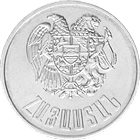
|

|
10 luma[10] | 16 mm | 0.6 g | Aluminium | Smooth | Armenian coat of arms | Value, year of minting | ||||

|
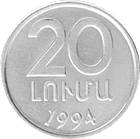
|
20 luma[11] | 18 mm | 0.75 g | ||||||||

|
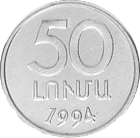
|
50 luma[12] | 20 mm | 0.95 g | ||||||||

|
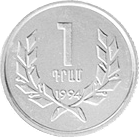
|
1 |
22 mm | 1.4 g | Reeded | |||||||

|
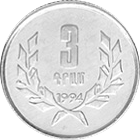
|
3 |
24 mm | 1.65 g | ||||||||

|
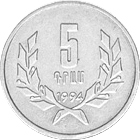
|
5 |
26 mm | 2 g | Smooth | |||||||

|
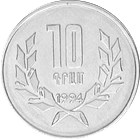
|
10 |
28 mm | 2.3 g | ||||||||
- All coins bear the year of the first issue (1994).
Second series (2003-present)[]
In 2003 and 2004, a new series of coins was introduced in denominations of 10-, 20-, 50-, 100-, 200 and 500 dram.
| Second series (2003-2004) | ||||||||||||
|---|---|---|---|---|---|---|---|---|---|---|---|---|
| Image | Value | Technical parameters | Description | |||||||||
| Obverse | Reverse | Diameter | Mass | Composition | Edge | Obverse | Reverse | |||||
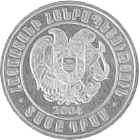
|

|
10 |
20 mm | 1.3 g | Aluminium | Reeded | Armenian coat of arms | Value, ornaments, year of minting | ||||
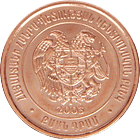
|

|
20 |
20.5 mm | 2.75 g | Copper-plated Steel | Smooth | ||||||
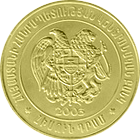
|
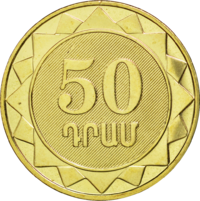
|
50 |
21.5 mm | 3.45 g | Brass-plated steel | Reeded | ||||||

|
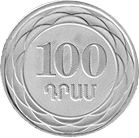
|
100 |
22.5 mm | 4 g | Nickel-plated Steel | |||||||
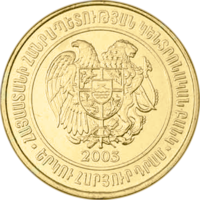
|

|
200 |
24 mm | 4.5 g | Brass | |||||||
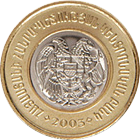
|

|
500 |
22 mm | 5 g | Bi-Metallic Copper-nickel center in Brass ring | Segmented reeding | ||||||
- All coins bear the year of the first issue (2003 or 2004).
Banknotes[]
A first series of banknotes was issued in November 1993. It was withdrawn from circulation by 2005. A second series was issued from 1998 onwards which is still in use at present.
First series (1993-1995)[]
On 22 November 1993, banknotes of 10, 25, 50, 100, 200 and 500 dram were issued.[23] Notes for 1,000 and 5,000 dram were put into circulation later.
| First series (1993-1995) | |||||||||
|---|---|---|---|---|---|---|---|---|---|
| Image | Value | Dimensions | Main Color | Description | |||||
| Obverse | Reverse | Obverse | Reverse | ||||||
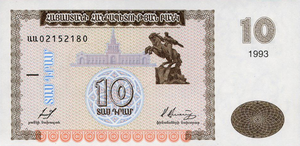
|

|
10 dram | 125 x 62 mm | Brown and purple | Yerevan Train Station and David of Sasun statue | Mount Ararat | |||
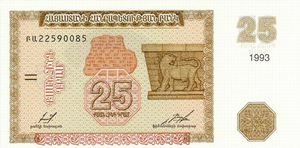
|
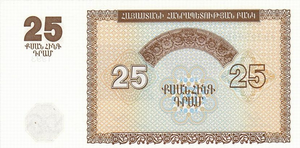
|
25 dram | Yellow, brown and blue | Urartian cuneiform tablet and a lion relief from Erebuni fortress | Ornaments | ||||
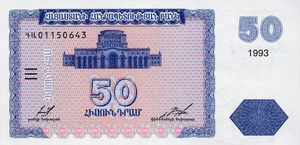
|
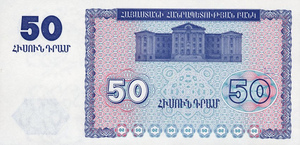
|
50 dram | Blue and red | National Gallery and History Museum of Armenia | Armenian parliament building | ||||
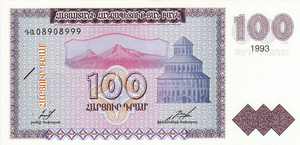
|
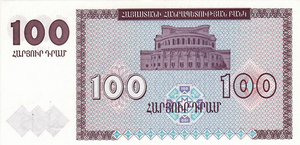
|
100 dram | Blue, purple and red | Mount Ararat and Zvartnots Cathedral | Yerevan Opera Theatre | ||||
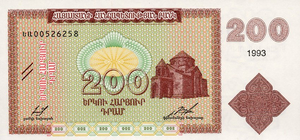
|
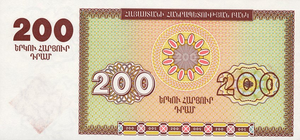
|
200 dram | 135 x 62 mm | Brown,green, yellow and red | Saint Hripsime Church in Echmiadzin | Ornaments | |||

|
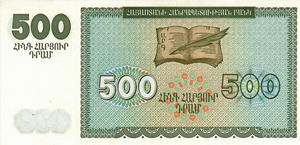
|
500 dram | Green, brown and blue | Mount Ararat and a Tigranes the Great tetradrachm | |||||
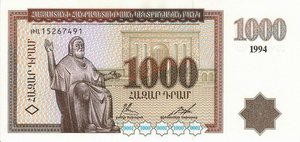
|

|
1,000 dram | 145 x 68 mm | Brown and orange | Mesrop Mashtots statue and Matenadaran | 7th century obelisk monument in Aghitu Memorial | |||
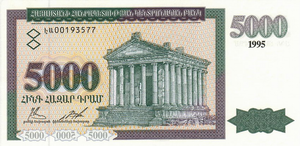
|
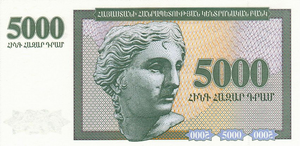
|
5,000 dram | 145 x 71 mm | Green, yellow and purple | Temple of Garni | Bronze head of goddess Anahit kept in the British Museum | |||
Second series (1998-2017)[]
Banknotes of 50-, 100, and 500 dram are rarely seen in circulation. The 50, 100, and 500 dram coins are used instead.
A commemorative 50,000 dram note was issued on 4 June 2001 in commemoration of the 1700th anniversary of the adoption of Christianity in Armenia. A 500 dram commemorative note was issued on 22 November 2017 to commemorate the story of Noah's Ark.
| Second series (1998–2017) | ||||||||
|---|---|---|---|---|---|---|---|---|
| Image | Value | Dimensions | Main Color | Description | ||||
| Obverse | Reverse | Obverse | Reverse | |||||
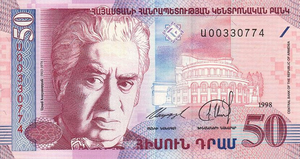
|
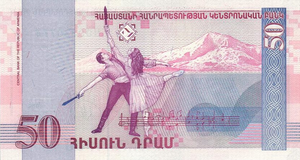
|
50 |
122 x 65 mm | Pink, blue and grey | Aram Khachaturian and Armenian Opera Theater | A scene from the ballet Gayane by Khachaturian, and Mount Ararat | ||
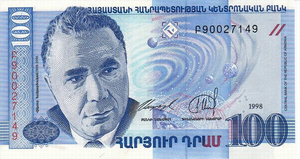
|
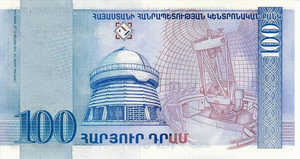
|
100 |
Blue and grey | Viktor Hambardzumyan | Byurakan Observatory | |||
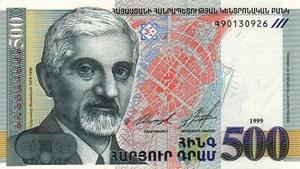
|

|
500 |
129 x 72 mm | Grey | Alexander Tamanian | Government House in Yerevan designed by Alexander Tamanyan | ||
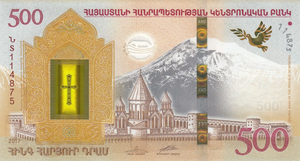
|

|
500 |
140 × 76 mm | Brown and grey | Reliquary containing a fragment of Noah's Ark (left); etching by Friedrich Parrot of Etchmiadzin Cathedral with Mount Ararat in the background | Etching by of Noah, his family members and animals against the background of Mount Ararat | ||

|
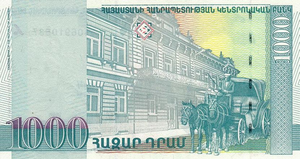
|
1,000 |
136 x 72 mm | Green and pink | Yeghishe Charents | An image of old Yerevan depicting the government building of the First Republic | ||
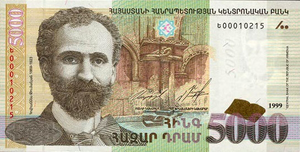
|

|
5,000 |
143 x 72 mm | Yellow and green | Hovhannes Tumanyan | Nature scene from Lori, from one of Martiros Saryan's paintings | ||
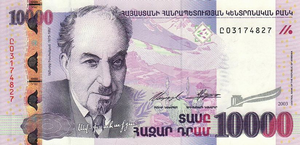
|

|
10,000 |
150 x 72 mm | Purple | Avetik Isahakyan | An image of old Gyumri | ||

|
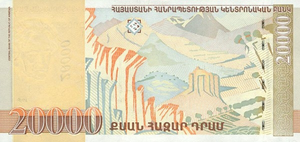
|
20,000 |
155 x 72 mm | Yellow, red and brown | Martiros Saryan | Detail from an Armenian landscape by Martiros Saryan | ||
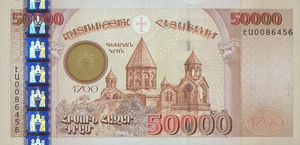
|
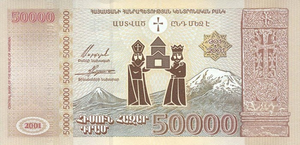
|
50,000 |
160 x 79 mm | Brown and red | Etchmiadzin Cathedral | St. Gregory the Illuminator and king Tiridates the Great holding a symbol representing the Armenian Church; on the right, a khachkar from Kecharis Monastery. | ||
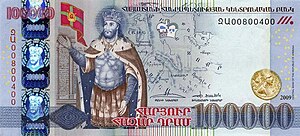
|
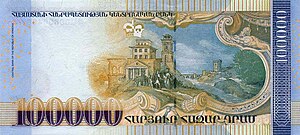
|
100,000 |
160 x 72 mm | Blue | Abgar V of Edessa | Abgar V of Edessa receiving the mandylion from St. Thaddeus (not pictured).[24] | ||
Third series (2018-present)[]
A third series of Armenian dram banknotes were issued in 2018, to commemorate the 25th anniversary of Armenia's national currency.[25] All denominations for this series are the same as its previous issues, with the 2,000 dram banknote as a newly introduced denomination, the 50,000 dram banknote re-issued for this series and the omission of the 100,000 dram banknote for this issue. The new series are printed on hybrid substrates of Louisenthal.[26]
The first three denominations, 10,000 ![]() , 20,000
, 20,000 ![]() and 50,000
and 50,000 ![]() , were issued on November 22, 2018. The final three denominations, 1,000
, were issued on November 22, 2018. The final three denominations, 1,000 ![]() , 2,000
, 2,000 ![]() and 5,000
and 5,000 ![]() were issued on December 25, 2018.
were issued on December 25, 2018.
| Third series (2018–present) | ||||||||
|---|---|---|---|---|---|---|---|---|
| Image | Value | Dimensions | Main Color | Description | ||||
| Obverse | Reverse | Obverse | Reverse | |||||
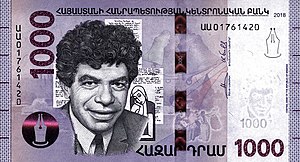
|
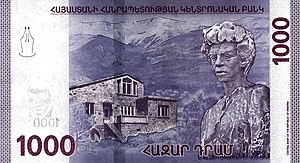
|
1,000 |
130 × 72 mm | Violet | Paruyr Sevak, poems | Paryur Sevak house (museum), Zangakatun; statue of Sevak | ||
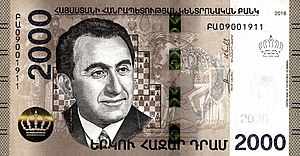
|
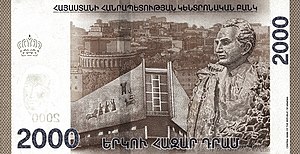
|
2,000 |
135 × 72 mm | Brown | Tigran Petrosian, chessboard | Tigran Petrosyan Chess House (Yerevan), statue of Petrosyan | ||
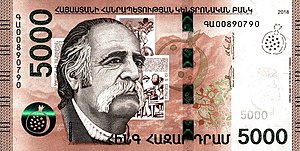
|
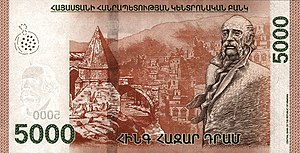
|
5,000 |
140 × 72 mm | Red | William Saroyan, covers from Saroyan's books, mountain | Statue of Saroyan (Yerevan) | ||

|
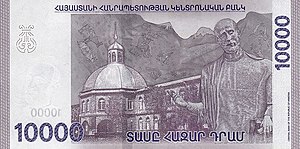
|
10,000 |
145 × 72 mm | Gray-purple | Komitas | Gevorkian Seminary and statue of Komitas, Vagharshapat (Etchmiadzin) | ||
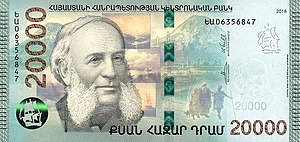
|
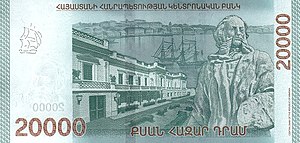
|
20,000 |
150 × 72 mm | Green | Ivan Aivazovsky | Art Museum and statue of Aivazovskiy, Feodosia (Crimea) | ||
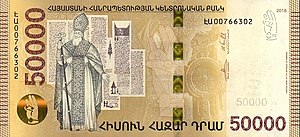
|

|
50,000 |
155 × 72 mm | Gold | Saint Gregory the Illuminator, manuscripts telling the life of St. Gregory, images of the dome of the Mother Cathedral of Holy Etchmiadzin and the winged cross | Khor Virap monastery (Chapel of St. Gregory), Ararat Plain, tombstone of St. Gregory the Illuminator (Etchmiadzin), statue of St. Gregory the Illuminator | ||
Exchange rates[]
The modern dram came into effect on 22 November 1993, at a rate of 200 rubles = 1 dram (1 USD : 404 AMD). The dram is not pegged to any currency other than the Artsakh dram.
| Current AMD exchange rates | |
|---|---|
| From Google Finance: | AUD CAD CHF EUR GBP HKD JPY USD RUB |
| From Yahoo! Finance: | AUD CAD CHF EUR GBP HKD JPY USD RUB |
| From XE.com: | AUD CAD CHF EUR GBP HKD JPY USD RUB |
| From OANDA: | AUD CAD CHF EUR GBP HKD JPY USD RUB |
| From fxtop.com: | AUD CAD CHF EUR GBP HKD JPY USD RUB |
Note: Rates obtained from these websites may be slightly different from the rates the Central Bank of Armenia publishes
See also[]
- Artsakh dram
- Economy of Armenia
- List of currencies
- List of currencies in Europe
- List of circulating currencies
References[]
- ^ Ter‐Matevosyan, Vahram; Currie, Brent (January 2019). "A conflict that did not happen: revisiting the Javakhk affair in Georgia". Nations and Nationalism. 25 (1): 18. doi:10.1111/nana.12454.
Javakhk was also brought into the lari (national currency of Georgia) zone around 2005 (previously the Russian ruble, followed by the Armenian Dram, was the main currency in circulation in Javakhk.
- ^ Øverland, Indra (2009). "The Closure of the Russian Military Base at Akhalkalaki: Challenges for the Local Energy Elite, the Informal Economy and Stability". The Journal of Power Institutions in Post-Soviet Societies (10). doi:10.4000/pipss.3717.
...the predominance of the Russian rouble as the principal currency of Javakheti, making the region a de facto part of the rouble zone. The second currency of Javakheti was the Armenian dram, whereas the Georgian lari was used so little that it could sometimes be difficult to get information about the rate of exchange.
- ^ "JAVAKHETI–ANOTHER PROBLEM AREA IN GEORGIA?". jamestown.org. Jamestown Foundation. March 7, 2002. Archived from the original on 4 September 2020.
Georgia’s national currency, the lari, has almost no circulation in Javakheti. Armenia’s dram and the Russian ruble are the everyday currencies.
- ^ "DOMESTIC CURRENCY - Artsakh".
- ^ Pomfret, Richard (2001). The IMF and the Ruble zone. Available at: http://www.readcube.com/articles/10.1057/ces.2002.17
- ^ Armenian commemorative coins for sale
- ^ Armenian commemorative coins cathalogue
- ^ BBC (2013). Available at: https://www.bbc.co.uk/news/magazine-21572359
- ^ Armenian Central Bank. www.cba.am
- ^ Central Bank of Armenia. Available at: https://www.cba.am/en/SitePages/detailsnccracoinsnotcirculated.aspx?nominal=1
- ^ Central Bank of Armenia. Available at: https://www.cba.am/en/SitePages/detailsnccracoinsnotcirculated.aspx?nominal=2
- ^ Central Bank of Armenia. Available at: https://www.cba.am/en/SitePages/detailsnccracoinsnotcirculated.aspx?nominal=3
- ^ Central Bank of Armenia. Available at: https://www.cba.am/en/SitePages/detailsnccracoinsnotcirculated.aspx?nominal=4
- ^ Central Bank of Armenia. Available at: https://www.cba.am/en/SitePages/detailsnccracoinsnotcirculated.aspx?nominal=5
- ^ Central Bank of Armenia. Available at: https://www.cba.am/en/SitePages/detailsnccracoinsnotcirculated.aspx?nominal=6
- ^ Central Bank of Armenia. Available at: https://www.cba.am/en/SitePages/detailsnccracoinsnotcirculated.aspx?nominal=7
- ^ Central Bank of Armenia. Available at: https://www.cba.am/en/SitePages/detailsnccracoinscirculated.aspx?nominal=1
- ^ Central Bank of Armenia. Available at: https://www.cba.am/en/SitePages/detailsnccracoinscirculated.aspx?nominal=2
- ^ Central Bank of Armenia. Available at: https://www.cba.am/en/SitePages/detailsnccracoinscirculated.aspx?nominal=3
- ^ Central Bank of Armenia. Available at: https://www.cba.am/en/SitePages/detailsnccracoinscirculated.aspx?nominal=4
- ^ Central Bank of Armenia. Available at: https://www.cba.am/en/SitePages/detailsnccracoinscirculated.aspx?nominal=5
- ^ Central Bank of Armenia. Available at: https://www.cba.am/en/SitePages/detailsnccracoinscirculated.aspx?nominal=6
- ^ "Central Bank Of The Republic Of Armenia". Cba.am. Retrieved 30 May 2013.
- ^ "Բիզնես 24 - Հայկական Բիզնես Օրաթերթ, 24/08/09". B24.am. 2009-08-24. Retrieved 2011-12-05.
- ^ "Arguments in Armenia over new banknote design". JAMnews. 2017-11-27. Archived from the original on 2018-01-12. Retrieved 2018-01-12.
- ^ "Armenia starts new series with Hybrid banknote". Securamonde.
External links[]
- Central Bank of Armenia
- Central Bank of Armenia next day USD to AMD exchange rate prediction Engine[permanent dead link]
- Armenian Dram Sign History, shape, and promotion of Armenian Dram Sign
- Coin Types from Armenia Lists, pictures, and values of Armenian coin types
- Coins of Armenia at CISCoins.net
- The banknotes of Armenia (in English and German)
- ISO 4217
- Currencies of Asia
- Circulating currencies
- Currencies of Europe
- Economy of Armenia
- Currencies introduced in 1993
- Currencies of Armenia
